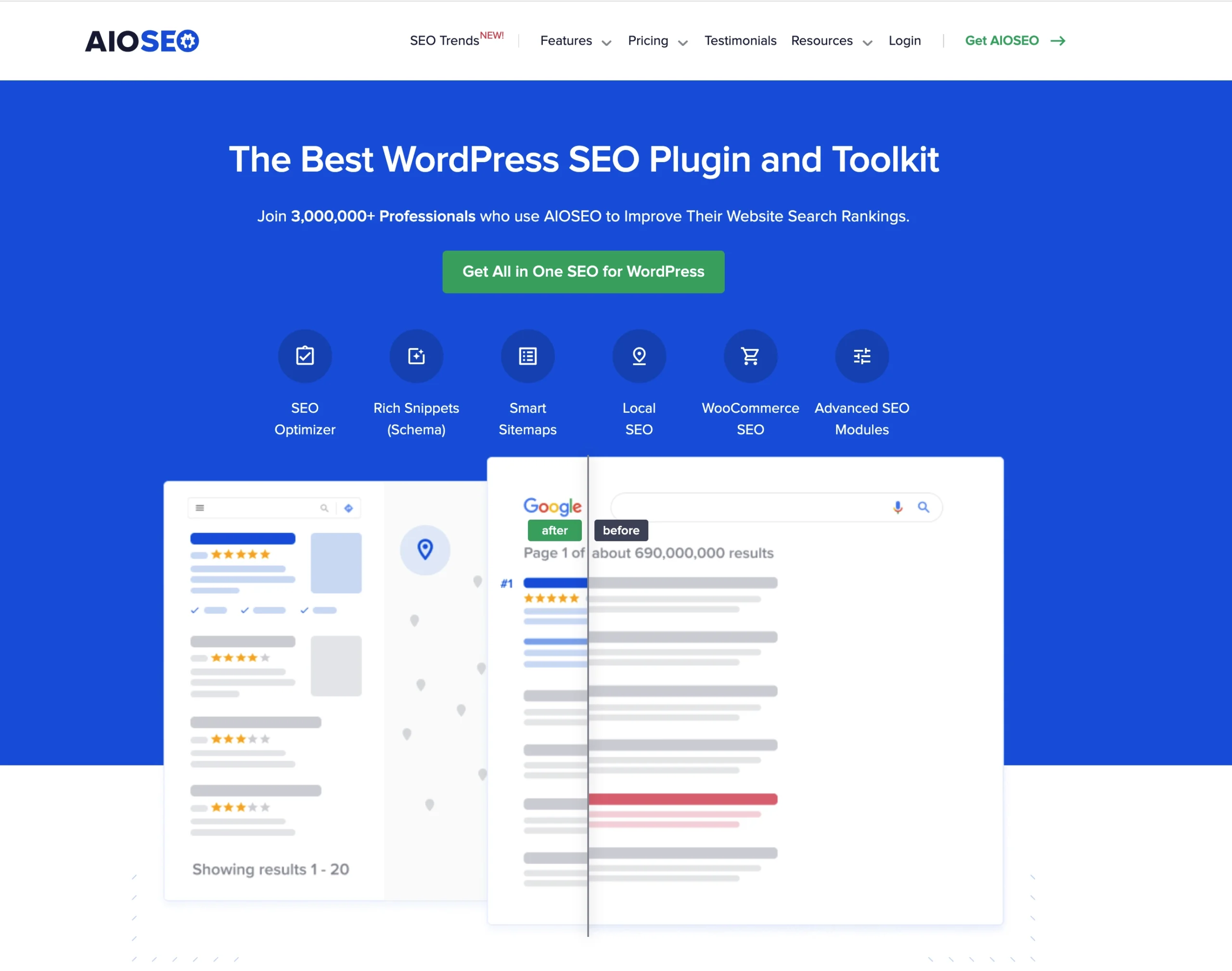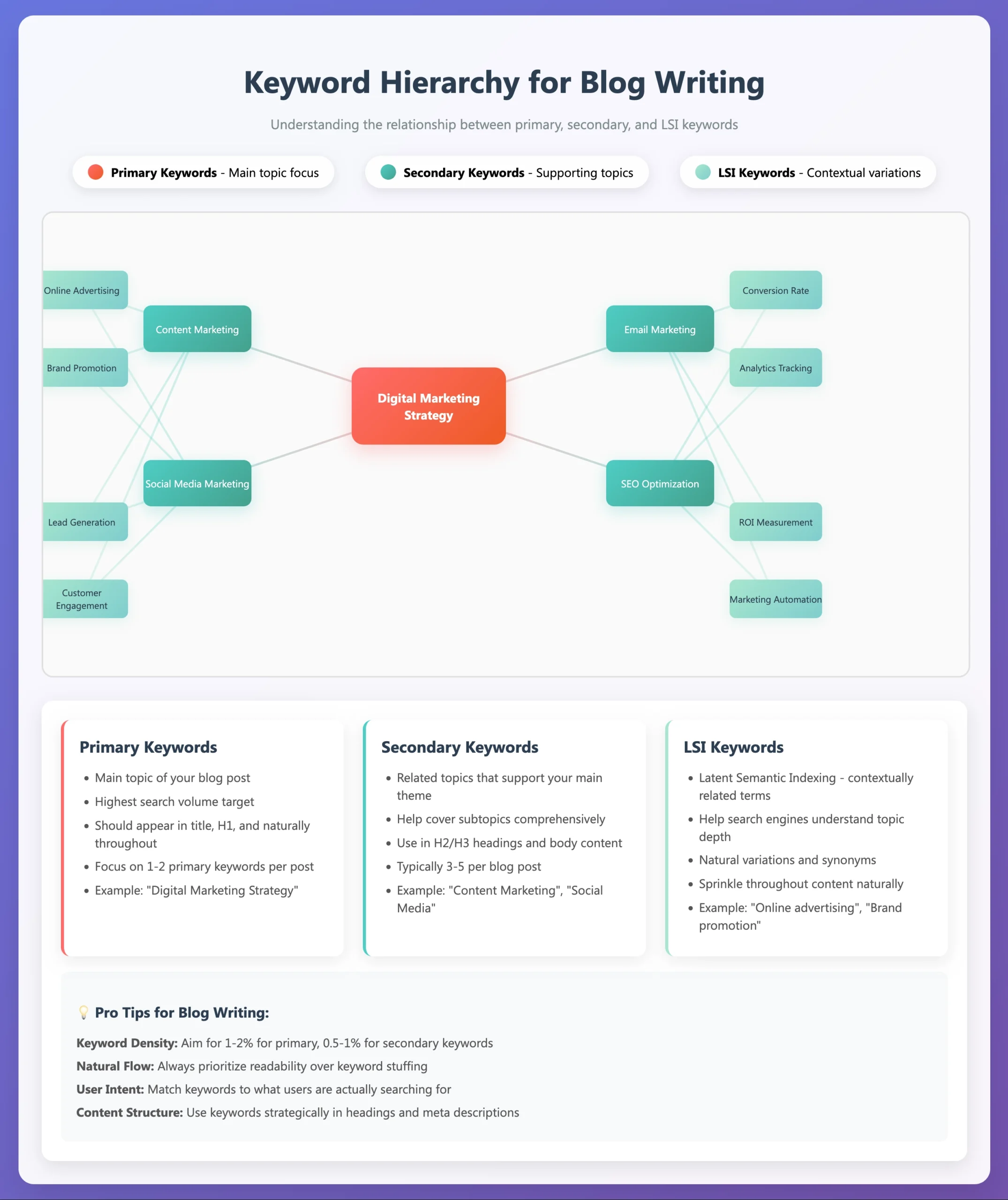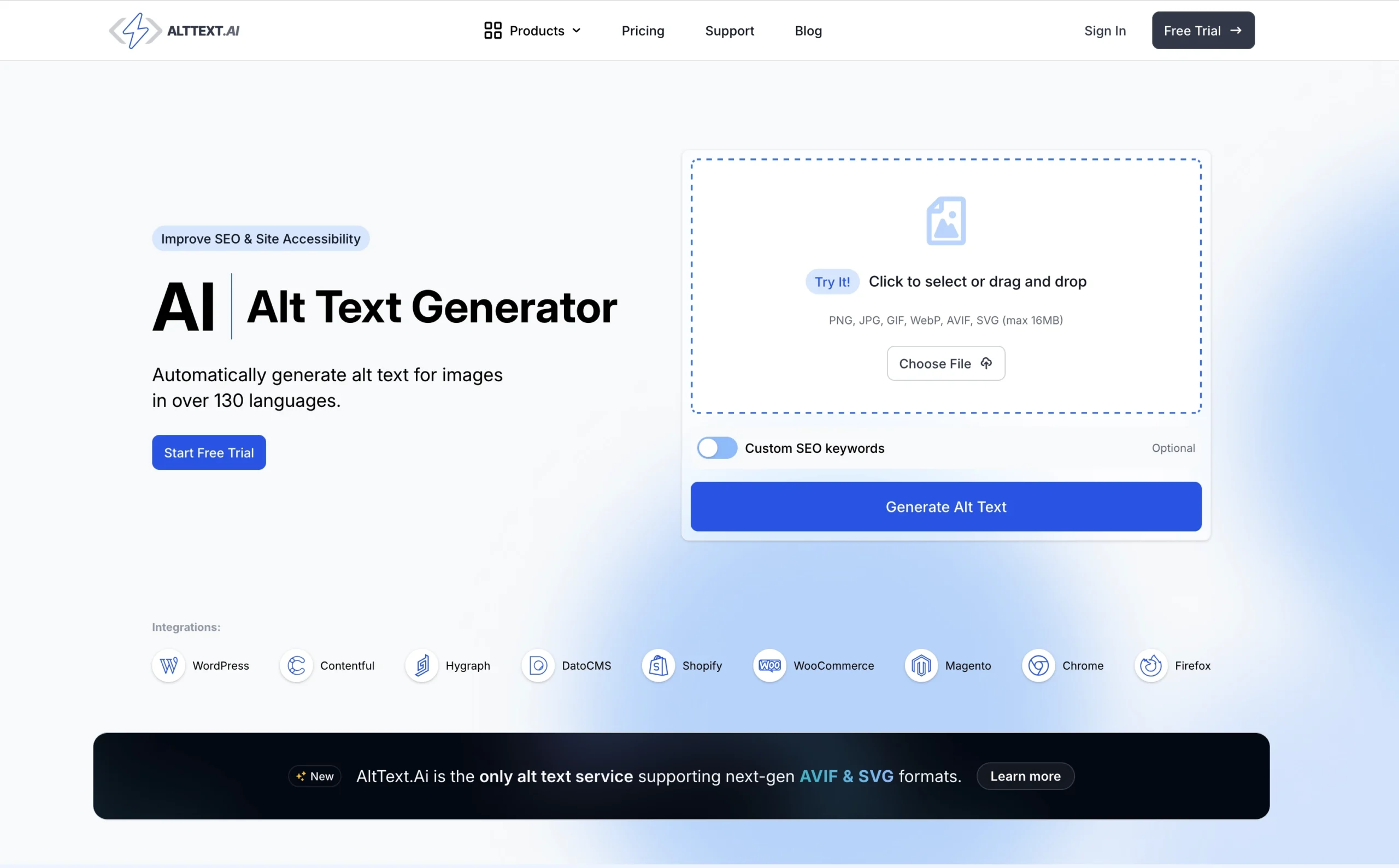Boosting your website rankings involves using content writing tools that help with SEO in several ways. First, thorough keyword research is essential to find topics your audience cares about, and tools like LowFruits and Semrush make this easier by revealing low-competition keywords.
Next, AI-powered assistants such as AIOSEO’s AI Writing Assistant streamline the optimization process by suggesting relevant keywords and analyzing competitors within your content editor. Structuring content clearly with headings, bullet points, and multimedia keeps readers engaged while also aiding search engines.

Lastly, monitoring performance through analytics helps you update content regularly to maintain strong rankings without sounding robotic or overloaded with keywords.
Understanding SEO Content Writing and Its Core Goals
SEO content writing involves crafting content designed specifically to rank higher in search engine results pages by targeting relevant keywords and matching user intent. The main goals of SEO content are to increase organic traffic, improve search visibility, engage readers effectively, and build authority within a niche.
Google’s E-E-A-T principles, Experience, Expertise, Authoritativeness, and Trustworthiness, play a crucial role in establishing credibility and improving rankings, so SEO content must demonstrate real knowledge or verified information. Since the first page of Google captures about 71% of clicks, ranking well is essential for visibility and traffic.

SEO content differs from generic writing by focusing on keyword optimization and aligning topics with user search intent categories like informational, navigational, transactional, or commercial searches. Quality and relevance are key factors in Google’s ranking algorithms, requiring content to satisfy both user needs and search engine requirements.
Authenticity is vital; sharing genuine experience or accurate data helps build trust with readers and search engines alike. Additionally, SEO content demands ongoing refinement based on performance metrics to maintain and improve rankings over time.
Conducting Effective Keyword Research for SEO
Effective keyword research starts with understanding your target audience’s search behavior. Knowing what terms and questions your potential visitors use helps you discover relevant keywords that align with their intent.
Tools like LowFruits are great for finding low-competition keywords, which can be easier to rank for, while Google Keyword Planner offers valuable data on search volume to gauge keyword popularity. For deeper insights, Semrush provides detailed keyword analysis and competitor strategies, allowing you to identify keyword gaps, opportunities where your competitors rank but you don’t.
It’s important to differentiate between primary keywords, which represent your main topic, and secondary or LSI keywords that provide contextual support. A balanced mix of short-tail and long-tail keywords ensures your content addresses various search intents, from broad to specific.

When selecting keywords, consider both difficulty and search volume to choose targets that are feasible and worthwhile. Grouping related keywords by theme helps organize your content structure logically, making it easier for both users and search engines to follow.
Finally, avoid keyword stuffing by integrating keywords naturally within your text, maintaining readability and flow. Regularly updating your keyword list is essential, as search trends and user behavior evolve over time, keeping your content relevant and competitive.
| Tool | Purpose | Key Features | Usage Tip |
|---|---|---|---|
| LowFruits | Identify low-competition keywords and keyword gaps | Finds easy-to-rank keywords, highlights opportunity gaps | Focus on keywords with low Keyword Difficulty (KD) to improve ranking chances |
| Google Keyword Planner | Discover keyword ideas and search volume | Offers basic keyword suggestions and monthly search volume data | Use for initial keyword discovery and volume validation |
| Semrush | Comprehensive keyword and competitor analysis | Provides keyword difficulty, competitor insights, related keywords, and trends | Combine with competitor content analysis to exploit keyword gaps |
Optimizing Content with AI-Powered Writing Tools
AI-powered writing tools like AIOSEO’s AI Writing Assistant, integrated right within WordPress, offer real-time keyword suggestions that help you naturally incorporate relevant terms without disrupting your workflow. These tools use SEOBoost technology to dynamically optimize your content as you write, ensuring your text stays aligned with the latest ranking factors.
With competitor content analysis features, you can benchmark your writing against top-performing pages and identify areas for improvement. Optimization grading highlights weak spots related to keyword use, readability, and structure, guiding you on where to focus your edits.
AI also suggests synonyms and latent semantic indexing (LSI) keywords, which enhance your content’s topical relevance and prevent keyword stuffing. Additionally, AI tools streamline the SEO process by reducing the need to jump between multiple platforms, allowing you to craft meta titles and descriptions that boost click-through rates automatically.
These assistants monitor keyword density and distribution to avoid penalties, while ensuring your content remains user-friendly and meets technical SEO standards. Overall, AI-driven writing tools provide practical, data-backed recommendations that keep your content optimized and competitive in search results without sacrificing readability or quality.
Beyond text optimization, accessibility plays a crucial role in modern SEO strategy.
Tools like alttext.ai specialize in generating descriptive alternative text for images, ensuring your visual content is both search engine friendly and accessible to users with disabilities. Proper alt text serves dual purposes: it helps search engines understand your image content for better indexing while meeting WCAG accessibility guidelines that are increasingly important for SEO rankings. This AI-powered approach to image optimization eliminates the tedious manual process of writing alt text, automatically creating contextually relevant descriptions that improve your site’s overall SEO performance and user experience.

These assistants monitor keyword density and distribution to avoid penalties, while ensuring your content remains user-friendly and meets technical SEO standards. Overall, AI-driven writing tools provide practical, data-backed recommendations that keep your content optimized and competitive in search results without sacrificing readability or quality.
Structuring Content for Better Readability and SEO
Organizing your content with clear headings (H2, H3) helps both readers and search engines understand the hierarchy of your topics. Descriptive, keyword-rich headings act as signposts, improving navigation and signaling relevance to search engines.
Breaking information into bullet points or numbered lists makes it easier to scan, which is crucial for users who skim content quickly. Step-by-step guides or how-to formats boost engagement by clearly outlining processes in a digestible way.
Keeping paragraphs short enhances readability across all devices, reducing reader fatigue and making the text less intimidating. Incorporate summary or takeaway sections to reinforce key points and provide quick refreshers.
Consistent formatting, such as uniform fonts, spacing, and alignment, improves the visual appeal and professionalism of your content. Use white space wisely to avoid clutter and give the eyes room to rest.
Embedding internal links within well-structured content guides readers to related topics and helps distribute SEO value across your site. Finally, maintain a logical flow so each section naturally leads to the next, keeping readers engaged and improving their overall experience.
- Divide content using clear headings (H2, H3) to signal topic hierarchy
- Use bullet points and numbered lists to make information scannable
- Apply step-by-step guides or how-to formats to improve user engagement
- Keep paragraphs short to enhance readability on all devices
- Use descriptive, keyword-rich headings to help search engines understand content context
- Include summary or takeaway sections to reinforce key points
- Apply consistent formatting for fonts, spacing, and alignment to improve visual appeal
- Utilize white space effectively to reduce clutter and fatigue
- Embed internal links within structured content to guide readers and distribute SEO value
- Prioritize logical flow so each section naturally leads to the next
Balancing Content for Search Engines and Human Readers
Creating content that appeals to both search engines and human readers requires a careful balance. Keywords should be integrated naturally, avoiding keyword stuffing that can disrupt the flow and turn readers away. Instead, use keywords strategically within relevant contexts to maintain readability and SEO value.
Following Google’s E-E-A-T model is crucial: share genuine experience and expertise to build trust. This means including personal insights, credible references, and trustworthy external links that support your points.
Transparency also matters, so clearly state author credentials and cite sources to reinforce authority. Engaging readers with storytelling and relatable examples keeps them interested and improves time on page.
Tools like AIOSEO’s Author SEO help craft structured author bios that highlight expertise and credibility. Checking readability scores ensures the content matches your audience’s literacy level, balancing technical terms with simple explanations to keep things clear and accessible.
Finally, regularly reviewing your content for tone and clarity helps maintain user engagement and ensures your message stays effective for both humans and search engines.

Using Multimedia to Enhance Content Engagement
Incorporating multimedia into your content is a smart way to boost engagement and improve SEO. Relevant images help illustrate key points and break up large blocks of text, making your content easier to scan.
Videos are especially useful for explaining complex topics or showing how-to processes, keeping users interested longer. Infographics summarize data visually, which helps readers retain information better, while charts and graphs can present statistics clearly and attractively.
To get SEO benefits, optimize image file names and alt text with keywords, and use captions to add context and improve accessibility. It’s important to balance multimedia with text so users aren’t overwhelmed, and ensure all elements load quickly and display well on mobile devices.
Interactive features like quizzes or sliders can also boost user participation and increase time spent on the page, which lowers bounce rates and signals quality to search engines.
Applying On-Page SEO Techniques with Writing Tools
On-page SEO is crucial for improving search rankings, and writing tools can make applying these techniques much easier. Start by crafting title tags that include your primary keywords while keeping the phrasing engaging to attract clicks.
Meta descriptions should also incorporate relevant keywords and clearly communicate the value of the content to boost click-through rates. AI-powered title and description generators can quickly provide multiple options, saving time and sparking ideas.
Internal linking strengthens your site’s architecture and helps search engines crawl your pages more effectively. Tools like AIOSEO’s Link Assistant automate this by suggesting relevant internal links as you write.

When structuring URLs, aim for short, keyword-rich, and easy-to-read formats, avoiding stop words and unnecessary parameters that clutter the URL and confuse users or search engines.
Proper use of header tags (H1, H2, H3) organizes your content into a clear hierarchy, making it easier for readers to follow and for search engines to understand the page’s structure. Adding schema markup helps search engines display rich snippets, which can improve your visibility and click rates.
Don’t forget to optimize images by compressing them for faster load times and adding SEO-friendly alt text. Regularly test and review your on-page elements with SEO tools to ensure they meet best practices and remain effective as algorithms evolve.
This ongoing attention to detail, supported by writing and SEO tools, helps maintain strong rankings and provides a better experience for users.
Crafting Headlines and Introductions That Drive Clicks
Creating headlines that grab attention is key to boosting SEO rankings and click-through rates. Use power words like “proven,” “ultimate,” or “essential,” and include numbers to make your headline stand out, such as “7 Tips for Faster SEO Wins.”
Incorporate your primary keyword naturally to ensure relevance to search queries. Questions or bold statements spark curiosity and invite clicks, for example, “Are You Making These SEO Headline Mistakes?”
Keep headlines between 50 and 60 characters to avoid them being cut off in search results, ensuring your message is fully visible. For introductions, lead with the reader’s pain points or interests right away to hook them.
Using storytelling or surprising facts can make your intro memorable and engaging. Applying the AIDA model helps: grab Attention, build Interest with benefits, create Desire by addressing needs, and prompt Action by setting clear expectations about what the article offers.
Keep the tone conversational to connect naturally with readers, making them feel understood. Whenever possible, test different headline and introduction variations with A/B testing tools to discover what drives the most engagement.
This approach not only improves clicks but also encourages readers to stick around, signaling value to search engines.
Focusing on Content Quality Over Length
When aiming to boost SEO rankings, prioritizing content quality over sheer length is essential. Clear, relevant, and original content that directly addresses user needs matters more than reaching a high word count.
Cover your topic thoroughly but avoid adding fluff or repeating information just to bulk up the text. Tailor the depth of your content to match user intent: provide concise answers for quick queries and in-depth explanations for research-focused topics.
Always ensure your facts are accurate and up to date, supporting claims with data, examples, or credible citations to build trust and authority. Keep sentences and paragraphs short to improve readability, and use smooth transitions to maintain a logical flow that guides readers naturally through your content.
Avoid filler content that doesn’t add real value, as this can dilute your message and hurt engagement. Regular content audits help identify thin or outdated pages that should be updated, merged, or removed to maintain overall site quality.
Monitoring user engagement metrics like time on page, bounce rate, and scroll depth can provide insights into how well your content meets user expectations, guiding ongoing quality improvements.
Incorporating Technical SEO Basics for Content Writers
For content writers aiming to boost SEO rankings, understanding and applying technical SEO basics is essential. Start by ensuring your content is crawlable: properly configure your robots.txt file so search engines can access important pages without restrictions.
Keep your XML sitemap clear and up-to-date to help search engines discover new and existing content efficiently. Implement schema markup to provide context about your content type, which can improve how your pages appear in search results with rich snippets.
Since Google prioritizes mobile-first indexing, make sure your content displays well on mobile devices by using responsive design and testing mobile usability. Page speed also matters, compress images and minimize code to reduce load times, enhancing both user experience and search rankings.
Broken links hurt your site’s credibility; tools like Broken Link Checker help identify and fix these issues promptly. Always use descriptive alt text for images to improve accessibility and assist search engines in understanding visual content.
Avoid duplicate content problems by applying canonical tags correctly, signaling the preferred version of a page. Structure your URLs logically, reflecting site hierarchy with clear, readable paths that include relevant keywords.
Regularly test these technical elements with tools such as Google Search Console and PageSpeed Insights to catch issues early and maintain optimal performance. By combining solid technical SEO practices with quality content, writers can ensure their work is both visible and valuable to search engines and users alike.
Tracking and Improving SEO Content Performance
Monitoring your SEO content’s performance is vital to maintaining and boosting rankings. Tools like AIOSEO’s Search Statistics module, which integrates with Google Search Console, allow you to track essential metrics such as search impressions, clicks, click-through rate (CTR), and average position.
By analyzing these metrics, you can identify your top-performing pages to understand what content resonates with your audience and performs well in search results. Equally important is spotting pages that are losing traffic or ranking positions over time, a phenomenon known as content decay.
Prioritizing updates on these pages by adding fresh information, optimizing keywords, improving readability, and fixing broken links can help regain or sustain rankings. Use keyword ranking trackers to monitor how your targeted keywords fluctuate in search results, and adjust your content strategy accordingly.
Beyond rankings, keep an eye on user engagement metrics like bounce rate, average session duration, and pages per session to evaluate how effectively your content holds visitors’ attention. Implement A/B testing for elements like titles, meta descriptions, and content formats to discover which variations drive higher CTRs and engagement.
Strengthen your site architecture and SEO performance by leveraging internal linking tools such as AIOSEO’s Link Assistant, which helps distribute link equity and improves crawlability. Don’t overlook technical SEO factors: regularly check page speed, mobile friendliness, and crawl errors using Google Search Console and PageSpeed Insights, then promptly fix any issues that could hurt content visibility.
Finally, create regular content performance reports that summarize insights, track progress, and outline action steps. These reports guide ongoing improvements, making your SEO content strategy more data-driven and effective over time.
Common Questions About SEO Content Writing Tools
Many wonder what the best SEO content writing tool is, and AIOSEO’s AI Writing Assistant often comes out on top due to its smooth WordPress integration, keyword suggestions, competitor analysis, and optimization grading all in one place. These tools help with keyword research by suggesting a mix of primary, secondary, and LSI keywords, including low-competition options that fit naturally into your content.
Improving readability is another key feature, as they offer real-time advice on structure, use of headings, and formatting like bullet points to make content easier to scan. On-page optimization is simplified by guiding users through optimizing title tags, meta descriptions, URL structures, and internal links to boost rankings.
Balancing writing for both humans and search engines is crucial, and SEO tools assist by encouraging natural keyword use while keeping content engaging and clear. Headline and introduction crafting is also supported, with features that analyze and even generate compelling, keyword-rich titles and hooks.
While these tools don’t insert multimedia directly, they remind writers to add relevant images, videos, or infographics to improve both user experience and SEO. Regarding Google’s E-E-A-T principles, some tools provide modules for structured author bios and content suggestions that highlight expertise, authority, and trustworthiness.
They also help flag technical SEO issues like keyword stuffing or broken links, and indirectly support page speed and mobile-friendliness through content recommendations. Lastly, certain tools like AIOSEO’s modules integrate with analytics platforms to track content performance, offering data-driven insights for continuous improvement.

Frequently Asked Questions
1. How do content writing tools help improve SEO rankings?
Content writing tools assist by optimizing your text for keywords, suggesting better readability, and helping to structure content that search engines favor. This can make your pages more relevant and easier for users to understand, which improves rankings.
2. Can content writing tools identify the right keywords to use in my posts?
Yes, many tools offer keyword research features that analyze search trends and competition. They suggest relevant keywords that fit your topic and audience, helping you target words that boost your content’s visibility in search results.
3. How do these tools ensure my content is original and not duplicated?
Most content writing tools have plagiarism checkers that scan your text against existing content online. This ensures your work is unique, which is important because search engines penalize duplicate content, keeping your rankings safe.
4. In what ways can content writing tools improve the user engagement on my website?
These tools help create clear, concise, and engaging content by suggesting better sentence structure, tone, and length. Improved readability and flow hold visitors’ attention longer, reducing bounce rates and signaling quality to search engines.
5. Are content writing tools useful for optimizing content beyond just keywords?
Definitely. Beyond keywords, such tools analyze factors like page titles, meta descriptions, internal linking, and overall content structure. They help align all these elements with SEO best practices, resulting in better rankings and a smoother user experience.
Conclusion
Boost your SEO rankings by combining solid keyword research with AI-powered writing tools like AIOSEO’s assistant for content optimization. Focus on clear structure, natural keyword use, and balancing content for both search engines and real readers.
Enhance engagement with multimedia, craft compelling headlines and intros, and apply on-page and technical SEO basics. Keep content quality high rather than just longer, and track performance regularly to update and improve.
Using integrated tools streamlines the process and helps meet Google’s E-E-A-T standards for better visibility and authority.




Leave a Reply